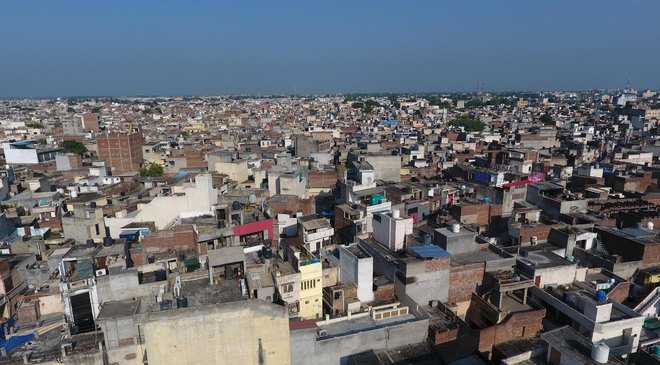
Rachna Khaira in Jalandhar
The Punjab Government enacted the Punjab Apartment and Property Regulation Act (PAPRA) in 1995 to provide a roadmap to colonisers for planning a large ecosystem of residential and commercial areas based on the sustained development without hurting the ecological balance of an area.
It’s 2018, and finding a home in an authorised colony still remains a distant dream for most Punjabis. While most of the government projects are in a limbo due to the shortage of land chunks, decades-long litigations and shortage of funds and staff, the development of illegal and unauthorised colonies is a booming business even today!
The background: Enactment of PAPRA (1995)
Before 1995, there was no such law that could clearly define the planning of a residential or commercial project. The colonisers were free to buy land and develop a project as per their plan.
However, the haphazard development put lot of pressure on the ecological balance in the state and even led to an unequal distribution of population in many pockets. This served as a trigger for bringing in some strict rules in order to prevent this haphazard growth. Hence, during the Akali-BJP regime, PAPRA was enacted in 1995. Also, felling the pulse of the people, the then Chief Minister of Punjab Parkash Singh Badal gave ‘aam maafi’ to all and regularised all unauthorised properties that had been constructed or bought before 1995.
The colonisers, who were working illegally, too, heaved a sigh of relief and welcomed the move and began to develop their projects after seeking licence from the Punjab Urban Development Authority (PUDA).
The game changer: Introduction of EDCs (1995-1997)
Everything was going on smoothly and for once it appeared that Punjab would soon be able to replicate itself on the lines of Chandigarh.
However, the dream was shattered in 1997 when the state government suddenly announced its intent to levy External Development Charges (EDCs) at the rate of Rs 7.7 lakh per acre on the colonisers.
According to Ludhiana-based coloniser Gurwinder Singh Lamba, PUDA while issuing a licence had taken an undertaking from the colonisers that they would pay proportional development charges on pro rata basis for any future development planned in and around their area. The colonisers were also asked to give a bank guarantee equivalent to their project cost to assure internal development in any PUDA-approved project or else they could face a jail term of up to three years. Hence there was no need to introduce separate charges.
“By that time, a majority of the colonisers had sold almost 90 per cent of their properties and were on the verge of closing down their sales. The sudden introduction of heavy EDCs on them meant a huge loss for them,” said Lamba.
To add fuel to the fire, PUDA even began to revoke bank guarantees of the colonisers pledged to assure internal development in order to recover ED charges. As a result many small-time developers even lost their own homes that they had pledged against the loans.
Perturbed over the ‘cheating’ and fear of further harassment, colonisers again turned towards developing unauthorised colonies.
An era of boom: EDC rationalisation (2002-2007)
A huge boom in the property business was reported in the state between 2002 and 2007 when Congress government led by Capt Amarinder Singh took over the reins in the state.
The CM not only rationalised the ED charges of an area according to its potential, he also offered lucrative schemes for mega projects.
While the ED charges for the highest potential area was fixed as Rs 3.5 lakh per acre, for a less potential area was fixed at Rs 2.5 lakh. Also, the least potential area, the ED charges were fixed at Rs 1.5 lakh per acre.
In another provision, the state government also empowered the Senior Town Planner (STP) to grant provisional licence to projects to be developed in less than 10 acres. The governmnet also waved off the Change of Land Use (CLU) provision for lands falling in the same zone of similar projects.
For the mega projects to be developed in over 100 acres of area, the government used to provide NOCs through a single window. It also used to help them in getting the land acquired for such projects.
According to Bhupinder Singh Bhinda, a Jalandhar-based coloniser, property sector saw the maximum boom during that time. “Over 85 per cent of the licenses issued till today were issued during that time only. Also, the number of EDC defaulters too reduced from 90 per cent to a mere 5 per cent,” said Bhinda.
Tough times: The downfall begins (2007 to 2012)
After the Shiromani Akali dal (SAD) took over the reins in alliance with the Bharatiya Janata party (BJP) in 2007, the property business again nose-dived in the state.
Major reason: The Akali regime increased the ED charges from Rs 3.5 lakh an acre to Rs 35 lakh. Even after massive protests, it reduced the charges to Rs 28 lakh, which was still way higher than the existing EDC. The government further clubbed EDC with an interest for delayed payments and also increased the minimum land holding to 100 acres. To add to the woes of stakeholders, the government also introduced Change of Land Use (CLU) chares from Rs 5 to Rs 7 lakh.
According to Jashan Chawla, another Ludhiana-based coloniser, acquiring 100 acres for a residential project was in itself a mega project. He said that it took him over three years to bring down the minimum holding requirement from 100 acres to 10 acres.
“However, with a huge hike in ED charges along with interest, the cost of a single project of 10 acres had gone up by Rs 4.5 crore, which was impossible for a developer to pay. As the developers had, in these three years, already bought huge land chunks to develop residential and commercial colonies, they could not find any way and hence developed illegal colonies,” said Jashan adding that the “lucrative business” that began in 2010 in the state is booming even today.
Hopes belied: Development authorities (2007)
Following a mushrooming of unauthorised colonies in the state, PUDA constituted six development authorities in Amritsar, Jalandhar, Ludhiana, Bathinda, Patiala and Mohali in 2007. However, except Mohali, these authorities failed to deliver in any of the other cities. With acute shortage of staff and alleged corruption prevalent in the departments, these authorities were nothing more than dummy bodies.
Power play: Situation worsens (2013 -2016)
In 2000, though there was no need for colonisers to take an NOC from PSPCL, they were asked to obtain an NOC in 2001. In 2003, they were also asked to pay for the 220 volt wire and also to bear the expenses of 11,000 KV wire. Finally in 2015, the colonisers were asked to get a separate substation of 66 KVA commissioned at their own expense (around Rs 2.5 crore) if the total load of their project would exceed 4 MW.
Present scenario: Deadlock remains
Even though the incumbent Congress government assured the colonisers to bring forth a policy on the lines of 2002-2007, it failed to deliver its promise even after a year of its rule. Even though the earlier SAD regime had offered to waive off EDC charges by 50 per cent, it had asked them to surrender over 33 per cent of their stakes to them.
“To worsen the situation further, the present regime has asked us to pay EDC charges and also to surrender 33 per cent stakes of our property. Though it assured us that the charges will be returned to us later on,” said Lamba.
Colonisation policies fail to woo (2010-2013)
From 2010 to 2013, the government announced three different policies but none of these was able to woo the colonisers to prevent them from developing unauthorised colonies. While the first policy, introduced in 2010, put additional EDC burden of up to Rs 40 lakh an acre on all the projects developed before and after 2007, another policy introduced in August 2013, too, caused huge outrage amongst the colonisers as the policy prescribed same EDC rates for projects situated in and up to 15 km from a city.
Though a third policy announced by the former Deputy Chief Minister of Punjab Sukhbir Badal was welcomed with great enthusiasm by the colonisers, it, too, lost sheen within 20 days of its announcement.
According to Lamba, even though the policy clearly stated that EDC charges should be taken on per acre basis, the officials made a shocking change on the 20th day — this was the announcement that EDC was to be collected on per sq yard basis. “This again created a lot of uproar amongst the colonisers as for many the cost of a project would increase by 400 per cent. Perturbed, everyone refused to accept it and finally returned to illegal developments”.



























